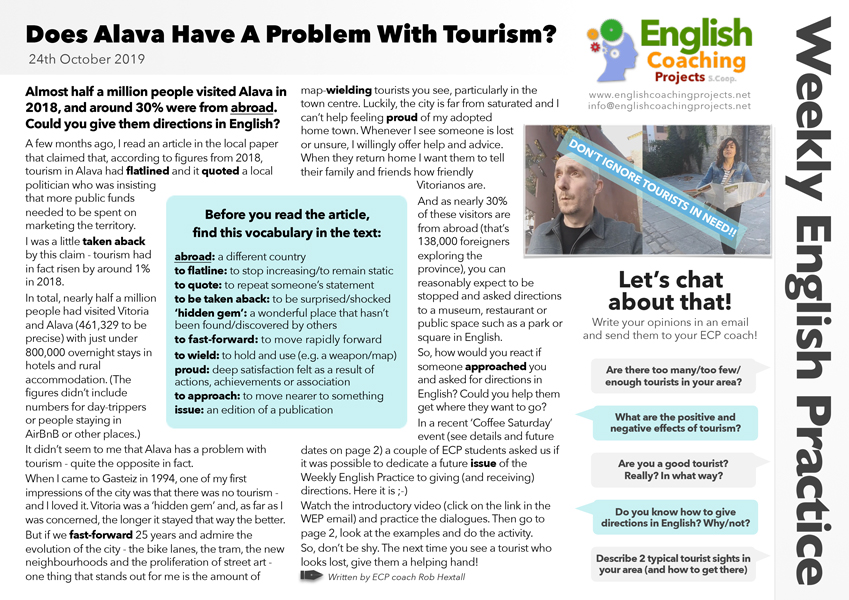Does Alava have a problem with tourism? How many tourists visit every year, and how many of them are foreigners? Read and listen to this week’s Weekly English Practice to find out!
Click on the image to download the pdf
Almost half a million people visited Alava in 2018, and around 30% were from abroad. Could you give them directions in English?
Before you read the article, find this vocabulary in the text:
abroad: a different country
to flatline: to stop increasing/to remain static
to quote: to repeat someone’s statement
to be taken aback: to be surprised/shocked
‘hidden gem’: a wonderful place that hasn’t been found/discovered by others
to fast-forward: to move rapidly forward
to wield: to hold and use (e.g. a weapon/map)
proud: deep satisfaction felt as a result of actions, achievements or association
to approach: to move nearer to something
issue: an edition of a publication
Listen to the audio (refresh the page if it’s not visible)
A few months ago, I read an article in the local paper that claimed that, according to figures from 2018, tourism in Alava had flatlined and it quoted a local politician who was insisting that more public funds needed to be spent on marketing the territory.
I was a little taken aback by this claim – tourism had in fact risen by around 1% in 2018.
In total, nearly half a million people had visited Vitoria and Alava (461,329 to be precise) with just under 800,000 overnight stays in hotels and rural accommodation. (The figures didn’t include numbers for day-trippers or people staying in AirBnB or other places.)
It didn’t seem to me that Alava has a problem with tourism – quite the opposite in fact.
When I came to Gasteiz in 1994, one of my first impressions of the city was that there was no tourism – and I loved it. Vitoria was a ‘hidden gem’ and, as far as I was concerned, the longer it stayed that way the better.
But if we fast-forward 25 years and admire the evolution of the city – the bike lanes, the tram, the new neighbourhoods and the proliferation of street art – one thing that stands out for me is the amount of map-wielding tourists you see, particularly in the town centre. Luckily, the city is far from saturated and I can’t help feeling proud of my adopted home town. Whenever I see someone is lost or unsure, I willingly offer help and advice. When they return home I want them to tell their family and friends how friendly Vitorianos are.
And as nearly 30% of these visitors are from abroad (that’s 138,000 foreigners exploring the province), you can reasonably expect to be stopped and asked directions to a museum, restaurant or public space such as a park or square in English.
So, how would you react if someone approached you and asked for directions in English? Could you help them get where they want to go?
In a recent ‘Coffee Saturday’ event (see details and future dates on page 2) a couple of ECP students asked us if it was possible to dedicate a future issue of the Weekly English Practice to giving (and receiving) directions. Here it is 😉
Watch the introductory video (click on the link in the WEP email) and practice the dialogues. Then go to page 2, look at the examples and do the activity.
So, don’t be shy. The next time you see a tourist who looks lost, give them a helping hand!
Written by ECP coach Rob Hextall
Let’s chat about that!
Write your opinions in an email and send them to your ECP coach!
- Are there too many/too few/enough tourists in your area?
- What are the positive and negative effects of tourism?
- Are you a good tourist? Really? In what way?
- Do you know how to give directions in English? Why/not?
- Describe 2 typical tourist sights in your area (and how to get there)


